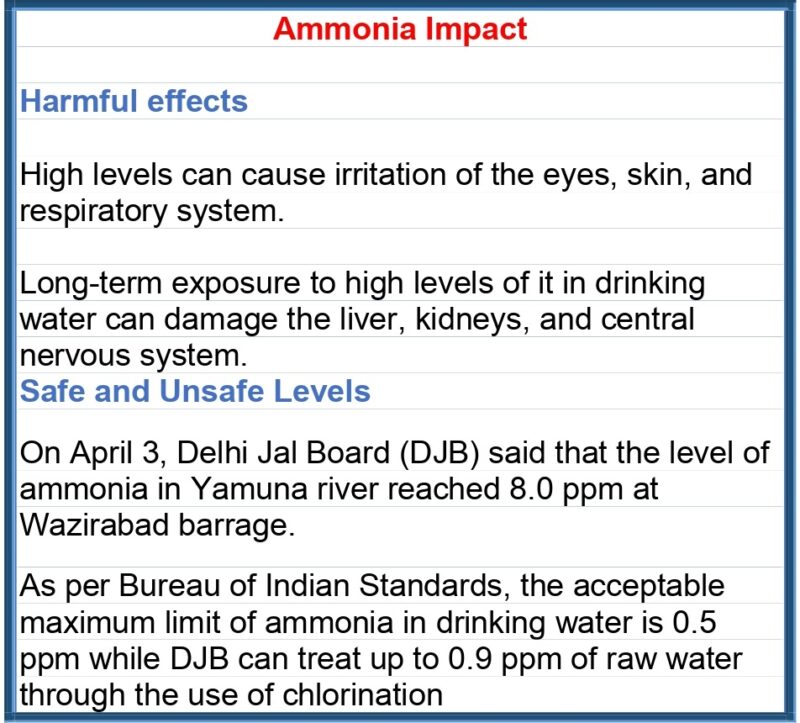Delhi, the capital of India, is facing a severe water crisis due to high levels of ammonia in the Yamuna river. The Yamuna is the main source of drinking water for the city and also serves as a major source of irrigation for farms in the surrounding areas. However, since March this year, high levels of ammonia have been reported in the river, which has resulted in a reduction of water supply to many parts of the city.
According to data from the Delhi Jal Board (DJB), the ammonia levels in the river at Wazirabad water treatment plant have remained consistently above 1 ppm for the majority of March. The levels increased from around 3 ppm on March 19 to over 5 ppm as of March 28.
As per Bureau of Indian Standards, the acceptable maximum limit of ammonia in drinking water is 0.5 ppm while DJB can treat up to 0.9 ppm of raw water through the use of chlorination.
On April 3, Delhi Jal Board tweeted that the level of ammonia in Yamuna river reached 8.0 ppm at Wazirabad barrage, which feeds the Wazirabad and Chandrawal water treatment plants.

The high levels of ammonia in the river have forced the DJB to curtail production by 10 to 50 percent at the Wazirabad and Chandrawal water treatment plants, resulting in low water pressure for residents.
The presence of high levels of ammonia in drinking water can have harmful effects on health. Drinking water with high levels of ammonia can cause irritation of the eyes, skin, and respiratory system. Long-term exposure to high levels of ammonia in drinking water can damage the liver, kidneys, and central nervous system. People with liver or lung disease are more vulnerable to high levels of ammonia.
Dr Rahul Sharma, Additional Director at Fortis Hospital, explained that high levels of ammonia in drinking water can affect the brain and nervous system, and long-term exposure can lead to coma, altered sensorium, giddiness or other neurological issues.
Sharma said that ammonia can also affect other parts of the body apart from the brain and liver. Due to the air pollution in the city, ammonia can also impact lungs and decrease lung capacity. When it comes to direct contact with the skin, it may also cause skin irritation and allergy.
According to Sharma, individuals with liver or lung disease are particularly susceptible to high levels of ammonia.
“When the liver is unable to detoxify ammonia levels, patients with liver disease may experience a range of symptoms such as coma, altered sensorium, giddiness, or other neurological issues. Regardless of its source, ammonia can cause significant harm to our bodies,” he added.

When asked about preventive measures to avoid health issues related to ammonia exposure, Sharma suggests that major public bodies should take action to curtail the issue. Specifically, curbing the amount of waste that factories release into rivers could help reduce ammonia levels in water. Regarding water purifiers, Sharma expresses uncertainty about their effectiveness in decreasing ammonia levels in drinking water. Ammonia is not a natural substance found in water, and therefore, he believes that purifiers may not be able to remove it entirely. However, he recommends ensuring that the water people drink is pure and does not contain high levels of ammonia.
Dr Charan Teja Koganti, a neuropsychiatrist, explained the mechanism behind how ammonia can affect the brain. “Our liver’s function is to detoxify. If your liver fails to do what it is supposed to do, especially in high concentration of ammonia, then excess ammonia goes into all the organs of our body through our blood. When it gets into the brain, there is a layer called blood brain barrier, which does not allow harmful substances into the brain. But when the levels of ammonia is high, it can enter into your brain. It causes a lot of neurological issues,” he says.
Charan warns that excessive levels of ammonia in the body can lead to various neurological issues, including impaired memory, difficulty in concentration, sleep disturbance, seizures, and fits.
“In severe cases, it can even lead to coma or other serious neurological dysfunctions. This is because excess ammonia can cause intracranial hypertension, creating pressure inside the brain,” he said.
Fortunately, there are medications available to treat these issues, However, people who drink alcohol or have compromised liver function are at greater risk, and even small amounts of ammonia in water can exacerbate the situation.





